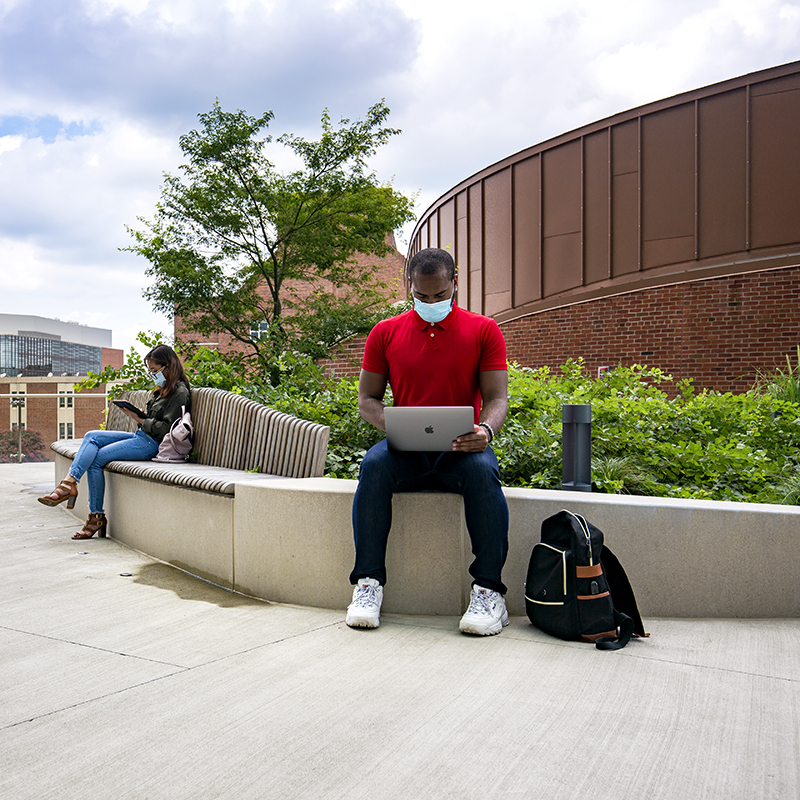
|
 |
Photo courtesy University of Maryland |
|
In this year of the COVID-19 pandemic, higher education institutions—like every other segment of society—have been forced to make critical decisions about how and when to reopen that could have significant health and financial implications. And because of the unprecedented nature of the pandemic, these decisions are being made with limited information, constrained resources and no reliable road map.
To fill in the gaps in knowledge about how to keep people safe in a university setting, three University of Maryland researchers have been awarded a two-year, $300K National Science Foundation EArly-concept Grant for Exploratory Research (EAGER) for Protecting University Communities from COVID-19 with Model-Based Risk Management.
The funding brings together a team experienced in analyzing infectious disease epidemics, formulating operational solutions, using models to predict disease spread down to the county level and evaluating social distancing policies, all with the goal of protecting public health. It includes principal investigator, Professor Jeffrey Herrmann (Mechanical Engineering and Institute for Systems Research in the A. James Clark School of Engineering); and two co-PIs, Professor Donald Milton (Applied Environmental Health) and Professor Hongjie Liu (Chair, Epidemiology and Biostatistics) in the School of Public Health.
“While there are existing models for how the epidemic of COVID-19 spreads, our work is innovative because of its focus on the unique university setting,” says Dr. Liu.
With the fall semester imminent after a volatile year, campus administrators across the country have struggled to formulate reopening plans. This has resulted in a patchwork of solutions for teaching and learning—from a continuation of online-only instruction, to hybrid models with limited student return to campus and a mix of live and online learning, to full campus, in-person reopening.
Yet any plan must keep students and the broader university community, including the neighborhoods and counties that surround the campus, as safe as possible from disease outbreaks. Better tools are needed to help colleges and universities make the vital decisions to keep students effectively and safely progressing toward their degrees in the context of the disease patterns and practices in the surrounding community.
“While the risk [of COVID-19 infection] for our student population may be low compared to the overall population, the speed and scope of an epidemic on campus could be very fast because of the nature of students living and being close together all the time,” Dr. Liu, who has been working with Maryland counties to project COVID infections over time and under different scenarios throughout this year, explained.
The research team is collecting data about testing coverage and infection rates among students and faculty members and residents in neighboring areas to inform their modeling of intervention strategies. They will develop a comprehensive, data-enabled disease spread model tailored specifically to university demographics and operations. It will take student behavior and university and surrounding community demographics into account, identify strategic options for educational delivery and suggest ways to integrate empirical and conceptual models of disease spread with dynamic data in higher education environments.
“We will include in our models the potential contributions from the different modes of transmission, how age impacts susceptibility and contagiousness and the impacts of universal mask wearing and testing strategies,” said Dr. Don Milton, whose research on airborne transmission of influenza, and now SARS-CoV-2, has received widespread attention. “This can inform decision making for control of future epidemics and pandemics not only on college campuses but also for educational environments more generally.”
Using novel mathematical and epidemic models that can estimate the trajectory of coronavirus infection, the effectiveness of mitigation strategies and predict the economic impact of different risk management options, the researchers will develop model-based decision support tools to help university administrators and public health officials evaluate their options.
These model-based decision support tools will be evaluated using an in-depth case study based at the University of Maryland.
“The models that we plan to build will help decision-makers understand both the advantages and disadvantages of different options so that they can select appropriate strategies for teaching and learning and research to occur safely,” said Dr. Jeffrey Herrmann, known for his work developing mathematical and simulation models of mass dispensing and vaccination clinics. “Using models that can estimate the risks and economic impacts will enable decision-makers to balance risk reduction, costs, and other objectives in a rational way.”
Related Articles:
Herrmann helping UMMS design and refine vaccination clinics
A Tech Rx for COVID Recovery at Home
Safe Storage
UMD Engineers Help Pioneer New Treatment for Respiratory Failure
Striking Up the Band Again—Safely
Aerosol Containment Chamber to Make COVID-19 Intubations Safer
Better, Cheaper COVID-19 Tests
Researchers Design Mobile COVID-19 Testing Booths
Forecasting COVID-19: New UMD Research Could Help
Clark School Engineers 3D Print Protective Face Shields
August 11, 2020
|

